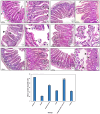Pumpkin seeds (Cucurbita pepo subsp. ovifera) decoction promotes Trichinella spiralis expulsion during intestinal phase via "Weep and Sweep" mechanism
- PMID: 38233460
- PMCID: PMC10794180
- DOI: 10.1038/s41598-024-51616-4
Pumpkin seeds (Cucurbita pepo subsp. ovifera) decoction promotes Trichinella spiralis expulsion during intestinal phase via "Weep and Sweep" mechanism
Retraction in
-
Retraction Note: Pumpkin seeds (Cucurbita pepo subsp. ovifera) decoction promotes Trichinella spiralis expulsion during intestinal phase via "Weep and Sweep" mechanism.Sci Rep. 2025 Aug 13;15(1):29707. doi: 10.1038/s41598-025-15100-x. Sci Rep. 2025. PMID: 40804113 Free PMC article. No abstract available.
Abstract
Trichinosis is a zoonotic disease of communal health concern as it instigated human outbreaks in several countries. Besides, the development of resistance, traditional therapy has numerous antagonistic effects. Thereby, finding efficient natural alternatives is required. In comparison to albendazole, this study evaluated the impact of pumpkin decoction on Trichinella spiralis in experimentally infected mice. The anthelmintic action of pumpkin decoction (500 mg/kg) was determined using T. spiralis infected mice in enteric phase for 5 days. Pumpkin decoction anthelmintic activity fortified by mixing with honey (1:1). Pumpkin decoction and Pumpkin decoction-honey mixture were evaluated by comprising with reference drug, albendazole (50 mg/kg). The T. spiralis adult count was significantly lower in all treated groups, with the pumpkin decoction-honey mixture showing the largest reduction (83.2%) when compared to the infected group (P ≤ 0.001). The intestinal histological changes and the level of COX-2 expression in the intestinal tissue were both significantly reduced in the same group. The pumpkin decoction improved the immune response, as evidenced by a significant decrease in nitric oxide (NO) and tumor necrosis factor (TNF-α) and a significant increase in the expression of the transforming growth factor (TGF-1β) and interleukin-17 (IL-17). The pumpkin decoction's anthelmintic action was facilitated by the TGF-1β and IL-17-driven Weep and Sweep mechanism. Both administration of pumpkin decoction beside honey showed the best treatment group that resulted in high infection reduction besides amelioration of biochemical markers and restoration of histological to normal state. In conclusion, pumpkin decoction is highly effective against T. spiralis which could be a promising alternative herbal drug and the pumpkin decoction effect was higher in the case of combination with honey.
© 2024. The Author(s).
Conflict of interest statement
The authors declare no competing interests.
Figures





Similar articles
-
Prescription of Controlled Substances: Benefits and Risks.2025 Jul 6. In: StatPearls [Internet]. Treasure Island (FL): StatPearls Publishing; 2025 Jan–. 2025 Jul 6. In: StatPearls [Internet]. Treasure Island (FL): StatPearls Publishing; 2025 Jan–. PMID: 30726003 Free Books & Documents.
-
Protective and therapeutic effects of Lactobacillus brevis PQ214320 and Bacillus subtilis PQ198038 Against experimental Trichinella Infection.PLoS Negl Trop Dis. 2025 Aug 11;19(8):e0013331. doi: 10.1371/journal.pntd.0013331. eCollection 2025 Aug. PLoS Negl Trop Dis. 2025. PMID: 40788963 Free PMC article.
-
Retraction Note: Pumpkin seeds (Cucurbita pepo subsp. ovifera) decoction promotes Trichinella spiralis expulsion during intestinal phase via "Weep and Sweep" mechanism.Sci Rep. 2025 Aug 13;15(1):29707. doi: 10.1038/s41598-025-15100-x. Sci Rep. 2025. PMID: 40804113 Free PMC article. No abstract available.
-
The Black Book of Psychotropic Dosing and Monitoring.Psychopharmacol Bull. 2024 Jul 8;54(3):8-59. Psychopharmacol Bull. 2024. PMID: 38993656 Free PMC article. Review.
-
Systemic pharmacological treatments for chronic plaque psoriasis: a network meta-analysis.Cochrane Database Syst Rev. 2017 Dec 22;12(12):CD011535. doi: 10.1002/14651858.CD011535.pub2. Cochrane Database Syst Rev. 2017. Update in: Cochrane Database Syst Rev. 2020 Jan 9;1:CD011535. doi: 10.1002/14651858.CD011535.pub3. PMID: 29271481 Free PMC article. Updated.
References
-
- Muñoz-Carrillo, J. L., Muñoz-Escobedo, J. J., Maldonado-Tapia, C. H., Chávez-Ruvalcaba, F. & Moreno-García, M. A. Resiniferatoxin lowers TNF-α, NO and PGE2 in the intestinal phase and the parasite burden in the muscular phase of Trichinella spiralis infecton. Parasite Immunol.39, e12393. 10.1111/pim.12393 (2021). - PubMed
-
- Pozio, E. Trichinella spp. imported with live animals and meat. Vet. Parasitol.213(1–2), 46–55 (2015). - PubMed
-
- Abou Rayia, D. M., Saad, A. E., Ashour, D. S. & Oreiby, R. M. Implication of artemisinin nematocidal activity on experimental trichinellosis: In vitro and in vivo studies. Parasitol. Int.66(2), 56–63 (2017). - PubMed
-
- Ding, J. et al. Developmental profile of select immune cells in mice infected with Trichinella spiralis during the intestinal phase. Vet. Parasitol.231(77–82), 2017. 10.1016/j.vetpar.2016.07.019 (2017). - PubMed
-
- Abd-ELRahman, S. M., Dyab, A. K., Mahmoud, A. E., Mostafa, S. M. & Elossily, N. A. Antiparasitic activity of myrrh crude extract and myrrh volatile oil compared to albendazole against Trichinella spiralis muscular larvae in vitro. J. Egypt. Soc. Parasitol.50(1), 308–315. 10.21608/JESP.2020.113052 (2020).
Publication types
MeSH terms
Substances
LinkOut - more resources
Full Text Sources
Research Materials

